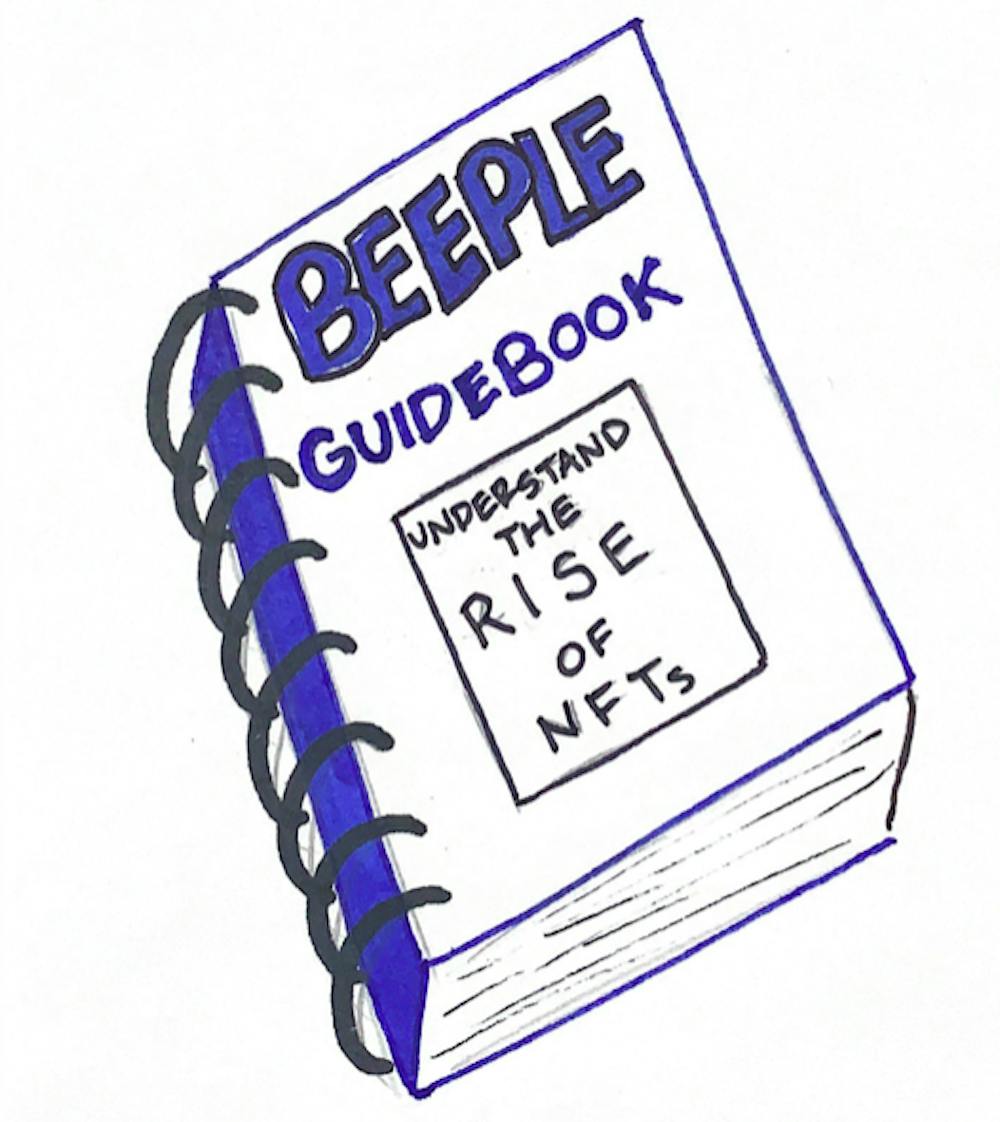On March 11, 2021, the oldest auction house in the world anointed a new mega-artist, Beeple (a.k.a. Mike Winkelmann), a digital artist famous for his dystopian political cartoons. Christie’s sold Beeple’s work through a non-fungible token, or NFT, for a closing bid of $69.9 million. This makes Beeple the third most valuable living artist in terms of auction prices after David Hockney and Jeff Koons.
An NFT records the sale of an image on a digital ledger — a blockchain — giving the buyer proof of authenticity and ownership of a digital asset on a secure, computerized network. For the art world, a market system notorious for backroom deals and lack of transparency, the introduction of blockchain has increased deal transparency by making information of deals public to any interested party. Christie’s presence in this market system, however, seems to undermine all of crypto’s core values; in particular, the fact that blockchains were developed to eliminate middlemen like Christie’s in the first place. Developed in 2008 by Satoshi Nakamoto, blockchains were established to eliminate the need of a central server or trusted authority, usurping the power of global conglomerates as intermediaries.
Christie’s self-insertion into the crypto market system, coupled with the numerous blatantly xenophobic, sexist and homophobic posits depicted in Beeple’s works, highlights problems in the late-capitalist art market system. Clearly, Beeple’s work is achieving new speculative heights with this Christie’s sale. One of his original NFTs which sold for $66,666.66 in October 2020 was resold for $6.6 million this past February. Why is a series of works by Winkelmann (a.k.a. Beeple) selling for $69.9 million when the market for his works was well below the $1 million range the year before? What does it mean for crypto now that the world’s oldest auction house has decided to dabble in the crypto market system?
At its core, this sale is the epitome of a successful collaboration: it increased the prestige of both parties involved. For Christie’s, they become the first major auction house to accept cryptocurrency as payment and the first major auction house to sell an NFT. Whether they make money or not, Christie’s walks away with fodder for a press kit on how they continue to innovate in the market. For Beeple, Christie’s gives legitimacy to both his art and NFTs as a technology of the future. In an attempt to justify the extraordinarily high prices, Christie’s cites Beeple’s 2.1 million Instagram followers, his productivity of creating a new work every day, and his collaborations with Louis Vuitton, Nike, Katy Perry and Childish Gambino. However, at its core, none of these rationalizations seem to justify a $70 million price tag: 2.1 million followers is nothing compared to the Kardashians, Picasso averaged two works a day and often made many more, and celebrity endorsements and designer collaborations are common for artists whose prices are much lower.
What we are seeing here is a collaboration formed with perfect timing, precision and organization — think Kanye West and Adidas’ Yeezy, Louis Vuitton and Takashi Murakami’s cherry-blossom bags, or Gucci and Dapper-Dan. In many ways, this collaboration creates an “emperor’s new clothes” dynamic, testing how much people will pay to own something that they can never truly own.
What is perhaps most unfortunate about this nearly $70 million work is that its format, a digital collage (or, as Christie’s calls it, a “digital mosaic”), obscures each of the 5,000 images into miniscule and unrecognizable thumbnails. If one actually takes the time to look through these 5,000 images, it only takes a few glances to sow the seeds of skepticism. Apart from the artist’s more recent and recognizable gross-out cartoons commenting on political and dystopic outrages, we also see hand-sketched images of Captain Crunch rebranded as “Cap’n Bitch” and sketches of Black bodies entitled “it’s fun to draw black people!” Other titles of his works include: “if i was one of them fancy-dancy elite art homos i’d call this ‘light study v1,’” “robot girl discovers 20th century black dildos (and then it's on like donkey kong),” “the dalai lama should give some girl the peace symbol but then like totally finger fuck her,” or “Uncle Bernie’s Trillion Dollar Superteat.”
These titles alone seem to underline my point. While I have no problem with political and societal satire, its conflation, through pricing, to artistic masters such as Picasso, Rembrandt, and Hockney gives me pause. Is Beeple truly the artist that millennials, and major brands, are lauding as “the next Da Vinci?” Furthermore, is it ethical for a company such as Christie’s to legitimize a white, middle-aged, male artist creating works with such problematic themes?
It seems that Christie’s has forgotten the responsibility of their role in the art market. Although it is a business, it is also one of the gatekeepers of art history. If people do not preserve the idea of what constitutes “good art,” then the entire art system will collapse. What we are seeing here is not a reflection of artistic achievement but a speculative frenzy just like the 17th century tulip craze or Wall Street Bets. Beeple’s work represents an important discourse between the art market and the digital world, but we cannot let the prices fool us. Only time will tell how Beeple’s oeuvre will evolve and how he will develop as an artist, but it seems clear to me that sketches of “Cap’n Bitch” do not equate to masterpieces by other artists in this price range.
Needless to say, I have mixed emotions about this sale. On the one hand, it is a historic moment in the art market, while, on the other, the amount of money involved may be damaging to the burgeoning NFT market. While Beeple and I may not agree on much, his reaction to the Christie’s sale sums up my own thoughts on the matter — “holy fuck.”
Hunter Parkhill is a member of the class of 2022.
Christie's, NFTs and Beeple: Speculative bubble or the future of art?

Comments



